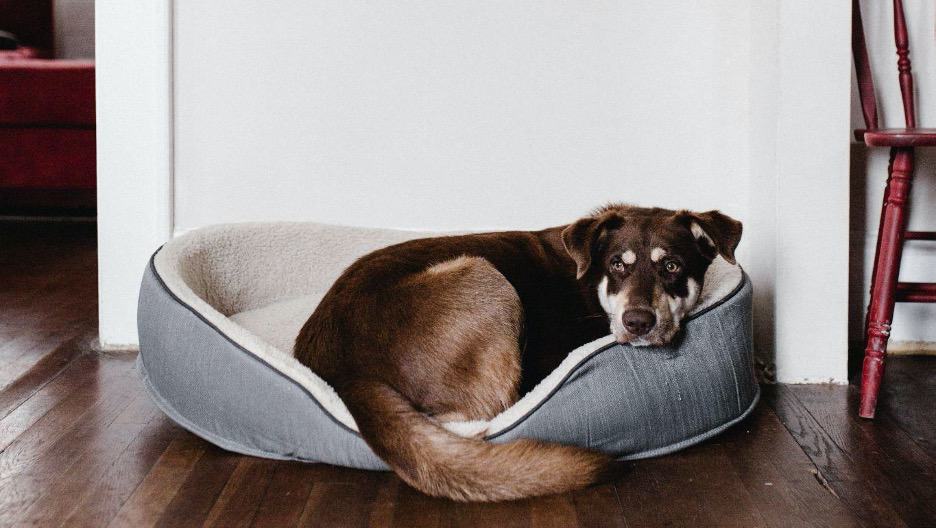How to Train Your Puppy to Sleep in His Bed

Introduction
Unlike popular opinion, pets, including dogs, are fond of burrowing spaces as they resemble the caves where wolves sought shelter, providing warmth, protection, and a restful night’s sleep. According to a study by the Mayo Clinic Proceedings, owners get better sleep with their dogs present in the room, but sharing a bed isn’t the case. A well-balanced sleep cycle is a vital component of a healthy lifestyle. The same is true for our beloved pets, especially if they are at a young age.
Puppies demand a safe, warm environment to feel comfortable to build initial trust with their parents. Pet parents tend to make the puppy sleep with them on the same bed they are sleeping in. While there is nothing wrong with it, pet parents need to understand that they can’t do the same for long. Like any other routine, having a sleep routine for your puppy will ensure his excellent night’s sleep. With a bit of planning, patience, and preparation, it is easy to help your puppy get into a healthy sleep routine.
Where Should the Puppy Sleep in the Night?

Having your puppy share the same bed as yours is entirely acceptable. However, it is not a sustainable option. Your puppy may cry at night for some unknown reason disturbing your sleep. There is also a chance of you unknowingly crushing him with your body weight. Puppies at a young age are quite impressionable and can associate your bed with sleeping, which could be a significant problem in the future. However, making them sleep in the next room or on the balcony is also not ideal. There is always a risk of them having anxiety about feeling left out and not comprehending the momentary separation from their parents. That is when having a proper sleeping habit for your dog becomes crucial.
Training your puppy to go to his bed to sleep over yours is just a matter of practice. The more you do it with your dog ensuring his comfort, the easier it will be for him to get used to it and make it a habit. Many factors define your puppy’s good night’s sleep. A bed that your puppy likes, the placement of that bed, the timings at which he goes to bed and gets up, and the training are some factors you would have to consider. These are some effective practices you can follow to mold your and your puppy’s sleeping routine in an excellent manner. Some routine procedures can deem helpful while training the puppy to sleep in his bed:
- Place 2-3 dog beds in different house spots to encourage the puppy to take his daily naps on them.
- Follow a nighttime routine with the puppy to prepare him before going to bed, i.e., going for a night stroll, offering a quick snack, grooming, saying goodnight to all family members, etc.
- Similar to humans, puppies can also be lulled to sleep with soft, musical notes in a darkened room to have a comfortable sleep through the night.
- Use a familiar object, such as a plush toy, blanket, etc., to ease him into being on his own for the night, or else you can also place a bed in your room if the puppy is acting restless.
- If you are crate-training your puppy, allow a fixed time for the washroom in the middle of the night to avoid unwanted behavior or bladder irritants.

While these tips and tricks can help ensure a good night’s sleep, owners must be cautioned to take proper care of their dogs in all aspects. Puppies are highly susceptible to external and internal flea infestation, which is why they require the appropriate method to prevent the disease. An easy, reliable, and convenient way is to get a monthly subscription that delivers medicine for fleas in dogs at your doorstep to guarantee your dog’s happy and healthy lifestyle.
How to Train Your Puppy to Sleep in His Bed?

Getting a new puppy to sleep is similar to going through the night with a newborn baby. Owners need to be committed to their training process and use the following steps to make putting their puppies to bed more effortless and effective. To train the puppy to sleep in his bed, here are the steps to be followed:
Step 1 – Use a Treat to Coax the Puppy into His Bed/Crate
Place your puppy’s favorite treat in a neat line leading to their bed and allow them to follow the trail until they’re comfortably seated on the cushion. In case the puppy halts in the middle, you can use a clicker to mark them while eating as positive reinforcement. Now start feeding the treat to your puppy from inside their bed and click every time it follows the instruction.
Step 2 – Use Positive Reinforcements to Encourage Positive Behavior
Associating the bed with a negative experience can drive the puppy away, thinking of it as an act of punishment. Thus, owners should communicate their appreciation by using encouraging phrases like “good job,” “good doggy,” and “well done!” to reinforce their positive behavior.
Step 3 – Allow the Puppy to Get Used to Going Toward the Bed
Once the puppy gets used to eating the treat in his bed, the next step is to get the puppy used to going toward the bed to eat the treat. To do this, you may first begin by using a release command such as “okay” or “release” to get them out of bed. Then pretend as if you’re throwing a treat inside their bed, and as they go towards it, use a clicker to mark their good behavior, followed by a treat.
Step 4 – Add a Command to the Training
Practice this repeatedly and once the puppy starts going towards the bed without entering it, add a command such as “sleep,” “lay down,” or “go to your bed” to the exercise. Once the puppy understands the command, owners need to wait and see if they are stepping into the bed on their own and treat them accordingly.
Step 5 – Use the Command From Different Rooms
Once the owners become assured that the puppy is following the cue, they can test in actuality by going to different distances and using the command on their puppy. Owners must remember that it will take repetitive efforts and training to help the puppy practice this exercise with precision, but by now, we know that consistency is the key to any dog training. The next and final step is for owners to go to a separate part of the house and command their puppies to sleep in their beds. It’s also good to treat your puppy if it stays in place for a long period of time and use the release command to get them out of bed.
Conclusion

While training, pet owners must practice patience and commitment to ensure that their puppy adjusts to a comfortable sleep routine through the night in a short period. While this may require several repetitions and efforts, with a few endless nights of whining and anxiety, the puppy will gradually make it a learned habit and follow it sincerely to sleep separately permanently. Owners should also understand that not all puppies are the same, and some will take more or less time to adjust to their sleep cycle and nightly routine. The key here is to lead your pet into thinking that their bed is a safe zone so that they can easily feel content and comfortable falling asleep.
Have a new puppy? Save thousands on vet bills, accidents, and emergencies with Odie Pet Insurance. Get a FREE quote!
How often should you be taking your pet to the vet? Read more here.



